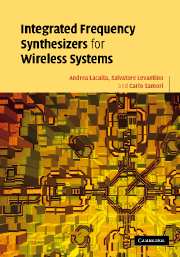7 - Noise up-conversion in VCOs
Published online by Cambridge University Press: 09 August 2009
Summary
Introduction
The analytical framework for the estimation of the oscillator phase noise provided in Chapter 5 needs to be supplemented by other mechanisms for frequency conversion of the noise source spectra. In particular, the presence of voltage-dependent capacitances either placed intentionally within the tank to provide resonance tuning or because of junctions of active devices, cause loading of low-frequency noise sources into the oscillator bandwidth. This may seriously compromise the close-in phase noise, because of the presence of large flicker noise of scaled technologies.
Wide tuning ranges and low close-in phase noise are mutually exclusive requirements. The limitation in the tuning voltage range dictated by the low-voltage supply of modern silicon technologies and the wide tuning range required to cover the LO band and to compensate for process and temperature variations may require high VCO tuning sensitivity KVCO. This problem is traditionally solved by employing a variable capacitance with an abrupt C–V characteristic. However, the oscillation frequency is no longer set by the tank resonant frequency, but becomes highly dependent on oscillation amplitude. Through this mechanism, all the noise sources present in the oscillator circuit that cause amplitude modulation noise produce, in turn, frequency and phase noise. [1]
Other mechanisms not related to voltage-dependent capacitances exist, and these may cause additional noise up-conversion. Some examples are the modulation of the active device delay and the effect of a low resonator quality factor.
- Type
- Chapter
- Information
- Integrated Frequency Synthesizers for Wireless Systems , pp. 157 - 181Publisher: Cambridge University PressPrint publication year: 2007



